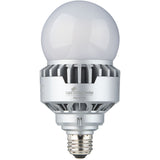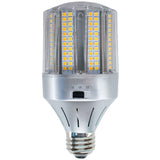How To Plan Outdoor Lighting That Minimizes Night Sky Light Pollution
Posted by Dave on for ProLampSales

The next time you walk through your downtown after dark take a minute to notice the lights – on buildings, on poles and post tops, along sidewalks.
How many of these light fixtures put the illumination only where it is required to meet the purpose of the fixture installation? There is a good chance you will see light spreading well beyond the intended target.
Much of the light will be illuminating the night sky, where it serves no purpose other than to obscure the enjoyment of stars. Often called "light pollution", outdoor electric lighting, unshielded from the sky, has only been increasing with the growth of urbanization worldwide.
In the U.S. alone, there are about 16.2 million public and commercial outdoor light fixtures including streetlights, parking lot lights, and lighting on commercial buildings. Much of this light is lost to the sky and shows up dramatically in satellite photos over urban centers.
Light pollution can also be seen in residential neighborhoods. Post top lights, landscape lights and security lights often produce omnidirectional illumination sending light both up toward the sky and across the property lines lighting up a neighbor's yard and house – "light trespass." Although residential outdoor lighting isn't as bright as that of public and commercial outdoor light fixtures, there's certainly a lot more of it – about 1 billion light fixtures in all!
Light pollution affects our enjoyment of the night sky and it affects astronomer's ability to do their research. Light trespass can aggravate neighbors and produce glare which detracts from the benefits of well designed outdoor lighting.
Use These Decision Guidelines for Outdoor Lighting
When planning any outdoor lighting project, consider these basic guidelines:
- Select light fixtures that put the light only where it is needed.
- Select light bulbs for the fixture that produce an appropriate brightness level.
- Minimize blue light emissions – use 3000K color temperature or lower.
Select Dark Sky Friendly Light Fixtures
The Illuminating Engineering Society of North America (IESNA) publishes a light "cutoff" classification system for outdoor fixtures that describes how much of the light distribution will go above the horizontal plane of the fixture – in other words toward the sky. There are four fixture cutoff categories: Full Cutoff, Cutoff, Semi-Cutoff and Non-Cutoff. To minimize light pollution from pole mounted area lighting and wall mounted security or decorative lighting choose fixtures the manufacturer specifies as full cutoff. These fixtures will direct the light toward the ground where it is needed and not allow light to escape to night sky.

Select an Appropriate Brightness Level
Residential outdoor lights are notorious for brightness levels that cause glare and detract from the appeal of the lighting. Generally warmer color temperature lights (2700K to 3000K) produce more pleasing results. But even where whiter light is desired, the lumen output should be chosen at lowest level that accomplishes the purpose of the light fixtures. This may require experimenting with different wattage bulbs.
Minimize Blue Toned Light
With the increasing use of LED and metal halide light sources for outdoor fixtures, blue wavelength light has raised concerns. Metal halide bulbs, often found in street lights and area lights tend to product light with a strong blue wavelength. LEDs are available in a broad range of color temperatures from warm white to very bluish-white light.
To visualize blue-white light, remember the last time a car coming toward you emitted headlight illumination that was distinctly more blue and appeared almost uncomfortably brighter than the headlights from other vehicles. Similarly, the LED landscape lights often found in home improvement stores, tend to produce more blue toned, high brightness white light.
The concern over blue toned light is health. Blue wavelengths affect sleep cycles in humans by suppressing melatonin which keeps people awake. While it could be argued this is a safety feature of blue rich light from roadway lighting, much outdoor lighting gets no benefit, and more likely aesthetic harm, from blue-rich landscape and building lighting.
The International Dark Sky Association (IDA) promotes municipal codes and provides information on limiting light pollution and light trespass. The IDA is an excellent source for more detail on these issues.
- Posted in Design, Landscape & Outdoor
Featured Products (View All)
0 Comments




